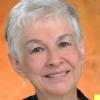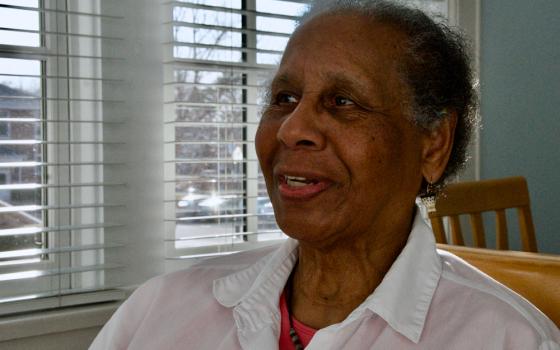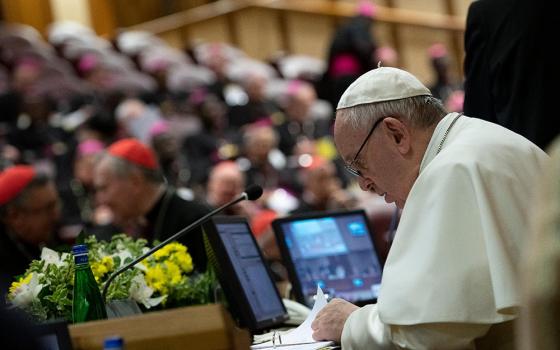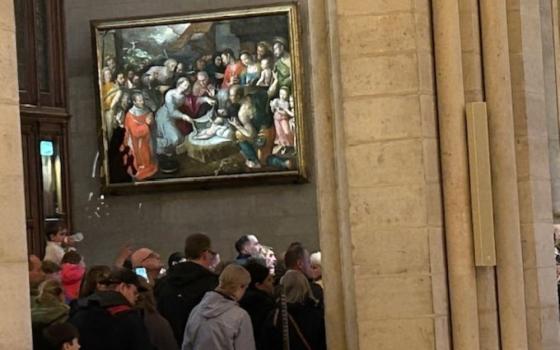
Sr. Kathleen Feeley of the School Sisters of Notre Dame holds a child at a village meeting in a small village near Sunyani, Ghana. (Courtesy of Kathleen Feeley)
Sr. Kathleen Feeley's career as a writer merged with her vocation as a nun beginning with her doctoral dissertation and continuing with her work as an English professor.
She learned to write well at the College of Notre Dame of Maryland in Baltimore as a student of the highly regarded poet Sr. Maura Eichner of the School Sisters of Notre Dame. But Feeley, also a School Sister of Notre Dame, didn't feel "the deep joy of writing" until she wrote her doctoral thesis, which became the book Flannery O'Connor: Voice of the Peacock.
Today, at 94, Feeley teaches poetry at the Renaissance Institute, a program for students over 50 that she founded in 1989 when she was president of the College of Notre Dame of Maryland.
She served as the president for 21 years. During that time, the school started its evolution from a small women's liberal-arts college to a university with 11 graduate programs, including doctorates in pharmacy studies, occupational therapy, and art therapy.
After Feeley retired in 1992, she founded the Caroline Center, a job-training center for women; led efforts to bring Baltimore City Public Schools into compliance with special-education laws; served as a Fulbright professor in India and China; and then taught as a visiting professor at the Australian Catholic University for one year. In 1999, she returned to the College of Notre Dame of Maryland as a professor of English.
Advertisement
In 2003, when she was 74, she went to Western Africa to teach at the newly founded Catholic University College of Ghana. When she wasn't teaching, she gave workshops on the educational philosophy of the School Sisters of Notre Dame in each of the congregation's schools in Africa.
In 2020, as the congregation celebrated 50 years in Africa, Sr. Oyin-oza Asishana, leader of the Province of Africa, asked Feeley to write the history of the School Sisters of Notre Dame on the continent.
This history became her recently published third book, How Beautiful!: School Sisters of Notre Dame in Africa: 1970-2020. She begins the book by writing that the Holy Spirit played an active role in the African province.
GSR: How does your writing connect to your vocation as a nun, specifically as a School Sister of Notre Dame?
Feeley: Writing is a spiritual experience for me. I listen for the voice of the Holy Spirit to help me communicate depth with clarity. With my first book, I experienced the inspiration that gave me the power to do this.
The two books that followed were requested of me by my congregation. I knew that I could make them inspirational even as I told the facts in story form. I was happy to spread the good news!

School Sisters of Notre Dame novices pose with their memoirs in Sunyani, Ghana. (Courtesy of Kathleen Feeley)
How did Sr. Maura Eichner influence your writing and your career? Mentioning her name brings back her evocative poem about teaching.
Sister Maura was a talented poet and teacher as well as a good friend. She deepened me by her poetry. She helped me to see writing as a way to glorify God. My college students at [Notre Dame of Maryland University] and in Africa learned what I had learned from her: to cherish the English language and use it effectively.
Tell me about the books you've written.
I wrote three books. The first, Flannery O'Connor: Voice of the Peacock, is a revision of my Ph.D. dissertation. I enjoyed clearing out all the "dissertation language" and just shared my knowledge of O'Connor's life, the spiritual depth of her stories, and the way she used violence to communicate the "inbreaking" of God into someone's life.
I was invited to write the other two books by the SSND leadership. That Deeper Knowing is the story of the Baltimore Province of SSND from 1847 to 2005, after which it merged with other provinces.

Sr. Kathleen Feeley outside the School Sisters of Notre Dame novitiate in Sunyani, Ghana (Courtesy of Kathleen Feeley)
How Beautiful! describes the missionary journey of many SSNDs to various countries in Africa, culminating in the founding of the Province of Africa in 2011. By 2020, African SSNDs numbered 80. The title is taken from the psalm that provided the theme: "How beautiful on the mountains are the feet of those who bring good news."
What courses have you taught?
My specialties are poetry and short stories. I have taught poetry of every type from many eras. I stress reading poetry aloud. My classes listen to my reading first, and then read [in silence] hearing their own voice, and then read aloud together, then listen in silence to their inner depths. Then we discuss.
I use every opportunity to teach Flannery O'Connor's short stories. The theological truths that each one embodies — the added dimension — is the heart of the matter.

Part of Notre Dame of Maryland University's campus in Baltimore (Courtesy of Notre Dame of Maryland University)
Tell me about your time as president of College of Notre Dame of Maryland (now Notre Dame of Maryland University). What is the highlight of your career there?
I was president of CNDM from 1971 until 1992. I enjoyed leading a creative institution that I revered.
For me, New Horizons was the highlight of that time. The program, initiated by SSNDs in 1981, brought women religious from all over the country to a four-week live-in summer program of renewal in the spirit of Vatican II. Talented and wise SSNDs staffed the program and invited guest speakers.
The goals of this multifaceted program were learning new theology, deepening understanding of the vows, renewing dedication, exploring self-assessment to reveal new talents, building community, and living holistically.
Creative prayer, contemplation and eucharistic celebration set the tone for each day. Sisters' roles as teachers or nurses expanded to new ministries; prayer became as diverse as each individual. Sisters designed new goals in ministry inspired by professional self-assessments. They experienced the call to embrace new horizons, even as they deepened their original commitment.
This ancillary program drew groups of about 30 women religious each summer for nine years.
Why did you go to Africa to teach after a very successful career as a university president?
One of my very good SSND friends spent several years teaching in Nigeria. She returned only because she needed surgery. After the surgery, she died from a blood clot. She inspired me to return to Africa in her stead.
I spent nine years teaching in Ghana and was blessed with a new understanding of myself because of what my students and my life there taught me.
In the preface to Francis: An African Story, you explain how you directed Francis Adams to write the story of his life, which became a published book. How did this happen?
In the first year of my teaching at CU of Ghana, I taught a freshman class to write memoirs. When Francis, a sophomore, saw the exhibit of those memoirs, he came to my office to ask me to help him write his autobiography.
I worked with him for two years, usually just correcting spelling and punctuation. He had his own storytelling style. His father died before his birth, and his mother shortly after. An orphan in Ghana, he is considered a bewitched person, to be shunned.
His story begins at birth and ends at his being a university student. It narrates many small miracles. When I came back to the States, through generous friends, I had his memoir published.

Francis Adams and Sr. Kathleen Feeley in Sunyani, Ghana (Courtesy of Kathleen Feeley)
What is the story behind your latest book, How Beautiful!: School Sisters of Notre Dame in Africa: 1970-2020?
After Vatican II, SSND provinces began sending educators to various countries in Africa beginning in 1970. Some sisters stayed a few years; others stayed a lifetime. After 10 years, the sisters were being approached by African women who wanted to join us.
Eventually, all the SSNDs in the various countries united, took steps to become a province, created a formation program and accepted African women. After they were professed, they joined us in ministry.
By 2011, expatriate SSNDs and African SSNDs had been working together for years, and the Province of Africa was formed.
How does the book connect to you personally?
I was part of this development for nine years. In 2003, I went to Ghana to teach. I returned home for a new assignment in 2010 and returned to Ghana from 2012 to 2014.
In 2020, the SSND leadership in Africa asked me to write the story of the creation of this new province. I finished the 50-year story in 2023.
A few of my expatriate friends are still ministering there, and I know some of the African sisters.
In the book, you mention the concept of "Trust and Dare." What does that mean to you? What should it mean to the rest of us?
Each SSND has a copy of a small book titled Trust and Dare with a daily quotation from our foundress, Mother Theresa of Jesus Gerhardinger. From it, I learned that if I have high-quality trust in God, I can dare anything. This truth has wide application!









